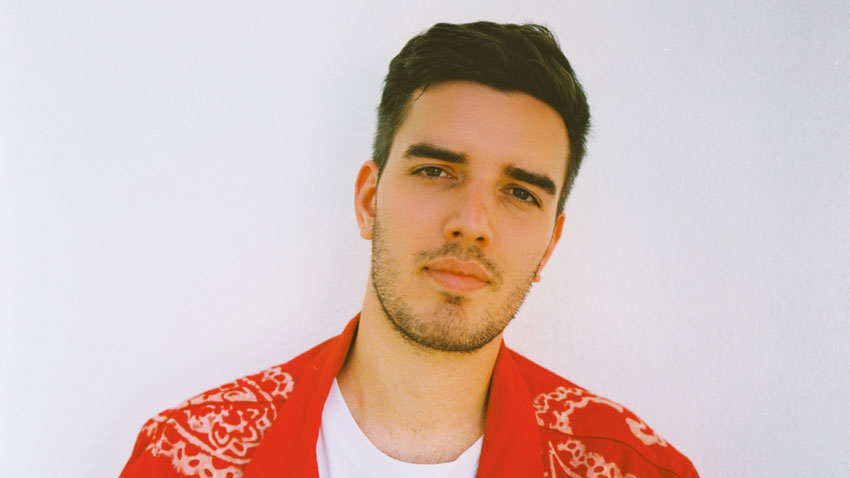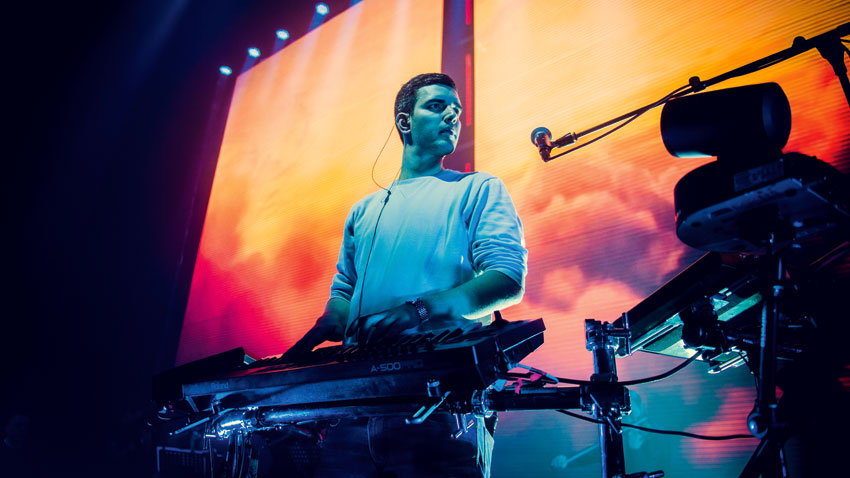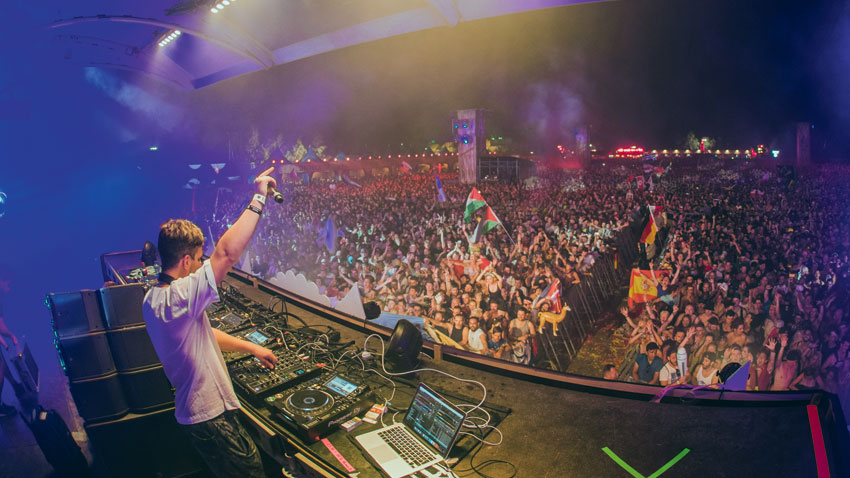Netsky: “I wanted to make catchy pop songs, but I also wanted to move away from straight-up 4/4”
The Belgian DJ and producer discusses his love for melodic drum ’n’ bass, live performance, and getting the most from your DAW

“From the age of two or three, I started to play rhythms on pots and pans in the kitchen. I guess my parents quickly realised they’d given birth to a drummer! My grandmother bought me my first kit when I was about five and I started having lessons a couple of years later. The drum teacher was great. Even though I was young, he started teaching me about hip-hop, R&B and funk. I didn’t know it at the time, but I was learning how to play and deconstruct breakbeats.
“I think he was trying to open all the music doors for me… to show me what was out there. I remember him going off to study African percussion and coming back with all these amazing sounds. Different ways to play the same beat.
“A few years later - I must have been about 12 - he started introducing me to other musicians in my hometown, Edegem in Belgium. One of the guys that came down was a DJ. Like most kids, I just thought DJs played records on the radio, but this guy was scratching alongside my drumming. I’d play a beat and then he’d answer me back on his turntable.
“That was the moment… that was when my life fell into place.”
Boris Daenen - aka drum ’n’ bass producer, Netsky - is struggling to keep the smile from his face as he tells us about how he discovered ‘beats’. Fresh from a year’s worth of festival and solo dates that took him everywhere from India to San Francisco, 29-year-old Daenen is back in Belgium, relaxing in his surprisingly basic studio. He still works mainly in the box.
Although he’s now able to cut down on the travelling, his musical life is still as hectic as ever. He’s decided to follow up his 2016 album, 3, with a two-album project called Palm Trees and Powerlines. Palm Trees will be home to poppier tunes; Powerlines will be full-on club grooves.
His November team-up with David Guetta, Ice Cold, was, unsurprisingly, pulled from Powerlines, but Daenen is hoping to release one track from each album every month.
Get the MusicRadar Newsletter
Want all the hottest music and gear news, reviews, deals, features and more, direct to your inbox? Sign up here.
“Even as a kid who was in love with beats, I was still attracted to fluffy pop songs,” he explains. “At last, I’ve found a way to make them both part of my life. Give them each their own platform!”
Wow! Learning to play the drums at five? Shouldn’t you have been busy collecting football stickers or building Star Wars Lego?
“Ha! That was my dad’s fault. All I can remember hearing in the house was crazy, experimental jazz. I was fascinated by these broken beats. They hypnotised me. I also think that I was quite a hyperactive kid, so crazy beats felt quite natural to me.”
No surprise that you eventually found a home with drum ’n’ bass, then?
“Absolutely! Yeah, I listened to pop and disco as well, but there was something about these furious rhythms that pulled me in. The energy of the music gave me the energy to live!”
After the meeting with the DJ that you mentioned, did you automatically think about making your own tunes or were you just interested in turntables at that particular point in time?
“For a couple of years, I pretended I was a radio DJ. I managed to scrape enough money together for one turntable and a cheap mixer, and I used to link them up with my dad’s stereo. I made my own programmes and hundreds of mixtapes.
“You could say that it was nothing more than childish fun and games, but there was a serious side, too. I was learning about music. Learning how songs were built and how they sounded… whether this song sounded OK after this song.
“Again, I have to thank my dad for the next stage. He showed me this piece of software he’d bought for his computer. It was very cheap and had different sets of drum loops, basslines and melodies that allowed you to create your own songs. It was a magic period in my life. I was amazed by these tools. With nothing more than a computer and some simple software, I could make my own music!”
How old were you at this point?
“Maybe 13 or 14.”
Had you already started listening to drum ’n’ bass? Seriously listening?
“At first, I was listening to house. Disco-influenced house from the 80s and 90; stuff like DJ Sneak, Derrick Carter, Stacy Kidd, Miles Maeda, Mark Farina, Miguel Migs. It was sample-heavy music, but it also had those soulful, repetitive grooves. It was machine music, but there was musicality and there was soul. You could hear the soul of its creator.
“I went to my first drum ’n’ bass night when I was 15. It was in Antwerp. As well as playing straight drum ’n’ bass, I heard a lot of remixes… remixes of big R&B and hip-hop tracks. I was hearing hit songs from the radio, but they had the energy of drum ’n’ bass. The track that really stood out for me was High Contrast’s reworking of Kanye’s Gold Digger. Of course, I knew the track because it was everywhere, but those soulful melodies had been given all this extra energy. Although it was the same song, people were dancing in a different way.
“That was the point where I felt comfortable. I wanted to make catchy pop songs, but I also wanted to move away from straight-up 4/4. I wanted to feel like I did when I was a kid listening to my dad’s jazz records… hypnotised by the beats. And, most important of all, I wanted to start making my own beats.”
The track that really stood out for me was High Contrast’s reworking of Kanye’s Gold Digger. Of course, I knew the track because it was everywhere, but those soulful melodies had been given all this extra energy.
Which needed a serious DAW…
“I started with FruityLoops. And I mean FruityLoops. The version I had was from before it became FL Studio. Looking back, that name change was probably the smartest move they ever made. FruityLoops was a great platform, but it sounded like breakfast cereal.
“After my time playing with preset beats and basslines, FruityLoops gave me a whole new world of sound. So much space. So much opportunity. And for the first time, I was hearing beats that I had created in my head.
“I did a year or so with FruityLoops, then moved to Cubase, then went through every DAW out there. I guess I was looking for a DAW that gave me some kind of special powers, but eventually I realised that they were all kind of equal. They all did the same things in slightly different ways.
“The journey finally ended at Ableton, but it could just have easily finished with FL Studio or Reason. If you can make music with all of them, does your choice of platform really matter?”
There must have been something that made Ableton Live ‘the one’…
“Like everybody says, it’s the workflow. You can create a track in minutes. And I still do that most days. I pull up Ableton and try to sketch two or three new ideas. Just a loop, a bassline, a melody and a couple of chords.
“As an instrument, it’s also very powerful, too. Simpler is just as good as Kontakt and super-quick. You can try different ideas in seconds, without having to interrupt the songwriting process. Obviously, you have to use good quality sample libraries. My main ones are probably Alicia’s Keys for piano and Session Horns for brass. I seem to be using a lot of brass at the moment.
“I don’t have a lot of third-party plugins on the computer. I’m a great believer in getting the best of what you’ve got in the studio. It is nice to have a few toys to play with, though. Getting access to all the Roland catalogue via their Cloud is fantastic!
“You also have to remember the live capabilities of Ableton. When I started making my own music, I immediately had dreams of playing it on stage. That’s maybe the one area where Ableton is so much better than the rest. It’s very happy to be the heart of a live show.”

Is that how most of your songs start? A quick jam into Ableton?
“Well… maybe. Because I’m a drummer and I’m in the drum ’n’ bass world, people think that I start every song with drums. The opposite is true. I always start with chords and melodies. I cannot deny that I love rhythms, but I think I love melodies even more. There has to be a song before the drums. That’s the only way it can flow for me.”
What’s your take on the idea that incredible drum programming without a decent song is just… a drum solo? Of course, you could point to work by Squarepusher, Aphex Twin, Burial, Danny Byrd or Noisia…
“Yes, I agree. In the early days, I think drum ’n’ bass was like that. It wasn’t about the song so much. It was sound design. It was an experiment to find out what effect you could have with the beat. And the feel was very harsh. A long way from a pop song.
“The difference for me - I’m talking about when I first started making my own drum ’n’ bass songs - was that I was also writing fluffy melodies. Not everyone liked that. I remember people saying, ‘Netsky is drum ’n’ bass for girls’. That made me happy! When I saw this discussion, I said, ‘This is my chance to take the music and make it my own’. I wanted to make drum ’n’ bass a little broader. What is the problem if a girl in high heels wants to listen to drum ’n’ bass? Maybe it was time to get away from sweaty basements and cans of Red Stripe.”
There was a period when it got very blokey. Then again, you could say the same about techno, jazz, heavy metal…
“I don’t have a problem with that. All I wanted to do was aim a little bit wider. And I was not the only one. There were a lot of my colleagues who agreed with me.”
I suppose that brings us, quite nicely, to the latest project. Two albums, two totally different sounds, but they’re both Netsky.
“Usually, when a producer spends more time in the studio, that producer will get closer and closer to the sound of perfection. A greater understanding of where a song needs to go. For me, I’m not so sure. If I am doing a remix or working in the studio with other people, yes, I think I have got better at knowing where I am going. For example, I recently did an EP with Stargate and all the pieces fitted together very naturally. The song was almost built by jamming together. Very human.
“But I noticed that when I was working on a Netsky song, I was a bit schizophrenic. Instead of me having a clearer picture of the sound I was after, things became less clear. The horizon became endless. One day, I was writing a nice, classical piece of music and the next day, things went completely hardcore. I wasn’t sure where I was supposed to be aiming.
“So, I said, ‘Why not have two albums? Day and night. Pop and rave’. Suddenly, I felt peaceful. The struggle was over. Give each sound its own home.”
The horizon became endless. One day, I was writing a nice, classical piece of music and the next day, things went completely hardcore. I wasn’t sure where I was supposed to be aiming.
Is there a difference in how you quantise a Palm Trees track and Powerlines track? You talked earlier about ‘jamming’ a song. Does that mean the Palm Trees tunes are a bit looser… less tied to the MIDI grid? Can you switch to maximum MPC swing or does drum ’n’ bass always have to be quantised to death?
“In my opinion, a beat doesn’t have to swing to be organic. You see some hip-hop producers and they go completely off-grid to get that dirty swing, but I believe that you can make a beat come to life without having to shift everything around. You have velocity, you have percussion, you have a choice of sounds… it takes a little bit of effort, but it is possible.
“I released two songs, recently. Téquila Limonada was from the Palm Trees collection, and the song I did with David Guetta, Ice Cold, was from Powerlines. Both drum tracks felt very different, but I also hope they both felt human.”
How was it that the Guetta collaboration came about?
“Last year, I decided to spend some time in LA. That’s where I met Stargate. For some reason, they decided to take me under their wing, which I am eternally grateful for. They are incredible pop producers and they taught me so much about pop music.
“Early this year, they were asked to work on David Guetta’s album and they took me along with them. We spent a month in the control room with David, working on different things. Initially, I was involved with sound design, but David heard a couple of songs I’d been working on and liked them. One of them was Ice Cold.”

You certainly took a lot of flak for making ‘drum ’n’ bass for girls’ in the early days. Do you think the world of electronic music - audiences and producers - has become more open-minded? Or do we still fear ‘change’?
“Ha ha! That’s an interesting question. All I can say is that, for me personally, it feels very refreshing to swap my music around. When I’m first writing a song, I will often change the key and change the groove every day. It’s nice to hear the song in a different way, with fresh ears. Sometimes, a song might go through 20 or 30 key changes before I find the one that fits. I like that freedom.
“OK, there is the danger that you can shoot yourself in the foot. You release the wrong song for the wrong audience. But I’m prepared for that. It’s part of the job. Music isn’t always about playing it safe. There are times when you need to take a risk. That’s how music grows and it’s also how you grow as a person.”


Computer Music magazine is the world’s best selling publication dedicated solely to making great music with your Mac or PC computer. Each issue it brings its lucky readers the best in cutting-edge tutorials, need-to-know, expert software reviews and even all the tools you actually need to make great music today, courtesy of our legendary CM Plugin Suite.










